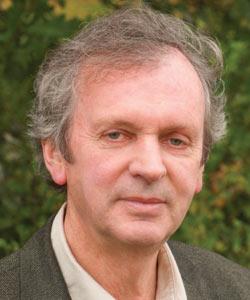Part two in a series. Read part one here.
Premonition, Precognition, and Presentiment
Sheldrake has collected a database of 842 cases of human premonitions, precognitions or presentiments, including people who see the future in dreams. He has also looked at the same phenomenon in animals.
He cites the case of British biologist Rachel Grant, who was carrying out a study on the mating of toads in Italy, only to observe a mass exodus of toads ahead of the 6.4-magnitude quake that struck Italy in April 2009. Grant told the press that her findings “suggest that toads are able to detect pre-seismic cues such as the release of gases and charged particles, and use these as a form of earthquake early warning system.”
But Sheldrake writes: “If it turns out that they are indeed reacting to subtle physical changes, then seismologists should be able to use instruments to make better predictions themselves. If it turns out that presentiment plays a part, we will learn something important about the nature of time and causation. By ignoring animal premonitions, or by explaining them away, we will learn nothing.”
Dean Radin, a U.S. academic, devised an experiment in the 1990s to test for presentiment. He monitored human subjects’ emotional arousal using electrodes attached to the fingers (as in lie detector tests). The activity of sweat glands, which varies following people’s emotional states, results in changes in skin resistance.
The subjects were shown various photos. Most photos showed calm things like landscapes but some were shocking, such as corpses cut open. A computer selected the them at random. When the calm pictures were displayed, the subjects remained calm; when the shocking ones were displayed, the increase in electrodermal activity could be measured via the electrodes.
Researchers were surprised to find that the increase in electrodermal activity occurred up to four seconds before the photo was shown to the subject, despite being selected only milliseconds earlier by a computer. Sheldrake writes: “People seem to be influenced by themselves in the future, rather than by objective events.”
He relates this to his own theory of morphogenetic fields. “This is in agreement with the way that attractors pull organisms towards their inherited or learned goals, with flows of influence from virtual futures through the present towards the past.”
Universal Constants May Not Be Constant
In addition to biology and philosophy of science, Sheldrake comes up with amusing and intriguing ideas in other fields of science.
Speaking of the speed of light, he writes, “By 1927, the measured values had converged to 299,796 kilometers per second. At the time, the leading authority on the subject concluded, ‘The present value of c [the speed of light] is entirely satisfactory and can be considered more or less permanently established.’
“However, all around the world from about 1928 to 1945, the speed of light dropped by about 20 kilometers per second. (...) In the late 1940s the speed of light went up again by about 20 kilometers per second and a new consensus developed around the higher value.”
Sheldrake says that in the future, scientific periodicals may carry regular news reports on the latest value of c, much like weather reports or stock-market indices.
Questioning the Conservation of Energy
The book discusses a range of experiments aimed at testing the conservation of energy in living organisms. This involves keeping humans or animals in airtight chambers and measuring energy input through food, heat and work produced, oxygen consumed, and carbon dioxide produced.
In some experiments, more than a quarter of energy is unaccounted for. In other experiments, Sheldrake holds that scientists averaged data from different experiments, and discarded some data to arrive at a result that followed the conservation of energy law.
“Although most people do not realize it, there is a shocking possibility that living organisms draw upon forms of energy over and above those recognized by standard physics and chemistry,” he writes.
Sheldrake goes on to tackle the phenomenon of “inedia,” wherein people do not eat for months or years without any adverse effects. He discusses the many holy people in India and the West, from past to present, who are said to survive without food, and in some cases water too.
Sometimes, the fasting seems to happen due to illness, rather than spiritual devotion. Sheldrake cites the 2010 study of Indian yogi Prahlad Jani [http://www.theepochtimes.com/n2/science/study-on-yogi-prahlad-janis-fasting-miracles-concludes-35126.html] who was monitored for two weeks by the Indian Defense Institute of Physiology and Allied Science.
Sheldrake calls for further study of the phenomenon: “Are there new forms of energy that are not at present recognized by science? Or can the energy in the zero-point field, which is recognized by science, be tapped by living organisms?”
Sheldrake relates the failure to experimentally verify the conservation of energy in living creatures to physics’ theory of dark matter.
When physicists observed the motion of galaxies and clusters of galaxies, they were surprised that the galaxies were not following the laws of the motion of matter. There seemed to be much greater gravitational attraction than should be possible. They thus concluded that a large amount of invisible matter must be present. They called it “dark matter” and it remains hypothetical and unobservable.
Cosmologists now believe that only a small fraction of the universe is made up of observable matter and energy such as atoms, stars, galaxies, gas, planets, and electromagnetic radiation. Most of the universe is made up of dark matter, they say.
Most theories of dark matter state that the density of dark matter is constant. Therefore, since the universe is expanding, dark matter is constantly coming into being. This refutes both the second law of thermodynamics, and the conservation of matter—two cornerstones of physics.
Sheldrake writes: “The universe is now like a perpetual-motion machine, expanding because of dark energy, and creating more dark energy by expanding.” He goes on to call out scientists on their prejudices against perpetual-motion machines: “Skeptics claim that all these devices are impossible and/or fraudulent, and some promoters of ‘free energy’ devices may indeed be fraudulent; but can we be sure that they all are?”
He says that misguided scientific advisers may be to blame for discouraging investment in research into “over unity” devices (which supposedly produce more than one unit of energy for every unit of energy put in). “But perhaps some of these devices really do work, and really can tap into new sources of energy.” He goes on to suggest a prize to be put up for the creation of such a device.
Alternative Medicine Should Become Mainstream
In addition to modern materialistic medicine, rival medical systems, such as homeopathy, chiropractic, and traditional Chinese medicine, are also widely used. However, government research, most national health services, and private medical insurance schemes ignore such rival systems, and stick to Western medicine.
Sheldrake begins by acknowledging the extraordinary achievements of modern Western medical science. The huge leaps forward in public health through immunization and improved hygiene were not thanks to any particular dogma, he says. Neither materialism nor the mechanistic theory of life should claim credit. Antibiotics also were discovered by chance. Most modern drugs are either chemical compounds isolated from herbal remedies or discovered by trial and error.
After a brief history of Western medicine, Sheldrake criticizes corrupt practices within the pharmaceutical industry. “Some companies go to great lengths to make their drugs look safer and more effective than they really are, creating an illusion of scientific respectability for their claims. [...] They offer large fees to scientists to put their names to articles that have been ghostwritten by authors paid by the drug company.”
Sheldrake goes on to tackle the placebo response. He relates this to the power of hypnosis on the body. He cites hypnotists’ abilities to induce blisters on the skin by convincing people they are being burned. He also cites the treatment of warts by “magical” methods as often being more effective than conventional ones.
When modern medicine tests a treatment’s effectiveness, it seeks to ignore the placebo response. Sheldrake asks the question: do some treatment methods give a better placebo response than others?
He then talks about the effect of spiritual practices on health. “The effects of prayer or meditation on health and survival have been investigated through prospective studies in which people who prayed or meditated and otherwise similar people who did not pray or meditate were identified at the start of the study and watched over a period of years to see if their health or mortality turned out differently. It did. On average, those who prayed or meditated remained healthier and survived longer than those who did not.”
He cites a U.S. study in which 1,793 over 65s were tracked for six years. After correcting for factors such as lifestyle, those who prayed had a 55 percent better survival rate. “If a new drug or surgical procedure had such dramatic effects on health and survival as spiritual practices, it would be hailed as a medical breakthrough,” he writes.
Sheldrake then urges the development of a new way to test treatment methods other than the randomized double-blind placebo controlled study. Mainstream and alternative treatments should all be compared so as to determine which one works best, which has the greatest variability of results between practitioners, and which is the most cost-effective.
On the sensitive question of end-of-life care, Sheldrake says patients who receive palliative care rather than aggressive treatments to prolong life lead better quality lives. Palliative care costs less, and in one study, lung cancer patients who received palliative care actually survived longer than those receiving aggressive anti-cancer therapy.
The Illusion of Objectivity
Throughout his book, Sheldrake challenges different assumptions and beliefs held by the scientific community. Scientists themselves are often unaware of their own prejudices, he says. Those who idealize science believe that scientists are “the epitome of objectivity, rising above the sectarian divisions and illusions that afflict the rest of humanity.”
He cites comedian Ricky Gervais as a prime example of a layperson having blind faith in the infallibility of science.
Scientists themselves perpetuate the ideal of the scientist as an objective, godlike, disembodied mind “freed from the normal limitations of bodies, emotions, and social obligations.” Stephen Hawkins has captured public imagination precisely because he is “as close to the disembodied mind as a human can be.”
Quantum theory has found that the very act of observing an experiment affects the outcome, but scientists still mostly write reports in the passive voice, as do schoolchildren in science class.
Sheldrake urges drastic reforms for scientific education, funding for science, and health care. At stake, he says, is the advancement of science, public health, mental well-being, and even the safety of our species, which is endangered by modern science’s effect on ecology.
The Epoch Times publishes in 35 countries and in 19 languages. Subscribe to our e-newsletter.



